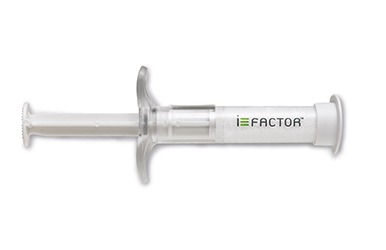
The use of i-FACTOR peptide enhanced bone graft (Cerapedics) resulted in a 50% fusion rate, compared to a 20% fusion rate using allograft in patients with non-instrumented surgery. This is the result of the IVANOS study evaluating i-FACTOR peptide enhanced bone graft in lumbar posterolateral spinal surgery. The conclusions were presented by Mikkel O Andersen (Sector for Spine Surgery and Research, Middelfart Hospital, Denmark) at the 7th Annual Global Spine Congress (GSC; 2–5 May, Singapore).
i-FACTOR peptide enhanced bone graft is based on proprietary synthetic small peptide (P-15) technology developed by Cerapedics to support bone growth through cell attraction, attachment and activation. In spinal fusion procedures, surgeons use bone graft to join and stabilise vertebrae. i-FACTOR peptide enhanced bone graft was approved in the European Union in 2008 and in Australia in 2010 for use in the repair of bony voids or defects in orthopaedic applications throughout the skeletal system. In the USA, i-FACTOR peptide enhanced bone graft was approved via a pre-market approval (PMA) in 2015 only for use in single level anterior cervical fusion procedures.
In the single centre, double-blind, randomised IVANOS study, 98 patients (240 treated levels) age 60 and older with lumbar spinal stenosis (LSS) and concomitant degenerative olisthesis (DS) were treated with non-instrumented lumbar posterolateral spine surgery and received either i-FACTOR peptide enhanced bone graft or allograft. Results demonstrated a 50% fusion rate (63/126) using i-FACTOR peptide enhanced bone graft compared to a 20% fusion rate (23/114) using allograft at one-year postoperative follow-up. Patients with 1-level DS achieved estimated fusion rates of 40% (29/72) with i-FACTOR peptide enhanced bone graft versus 21% (17/80) with allograft. Patients with two-level DS achieved estimated fusion rates of 63% (34/54) with i-FACTOR peptide enhanced bone graft versus 18% (6/34) with allograft.
“In Denmark the current surgical standard is the use of non-instrumented fusion in treating elderly patients with spinal stenosis and concomitant degenerative olisthesis. This patient population presents a challenging environment to obtain fusion due to their mechanical instability and biology,” says Andersen. “These data indicate that i-FACTOR peptide enhanced bone graft offers significant potential benefits in fusion rates compared to allograft.”
“This data from the IVANOS study is another significant milestone as we advance on our commitment to increase the level of clinical evidence evaluating our P-15 technology, and we are proud to be leading the effort to address the evidence gap around commercial bone grafts often used in spinal fusion procedures,” comments Glen Kashuba, chief executive officer of Cerapedics.
Cerapedics received approval from the US Food and Drug Administration (FDA) to initiate an investigational device exemption (IDE) clinical trial evaluating the safety and efficacy of its proprietary P-15 technology for use in transforaminal lumbar interbody fusion (TLIF) surgery in March 2018. The company is initiating enrollment in the study with the expectation that the results will support an additional Premarket Approval (PMA) application. P-15 currently remains investigational in the USA for use in the lumbar spine.
In autumn 2017, an IDE clinical trial found that the same peptide enhanced bone graft was demonstrated to be statistically superior to autograft in overall clinical success in anterior cervical discectomy and fusion (ACDF) procedures.












